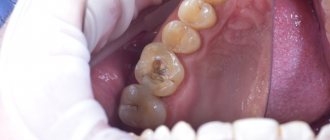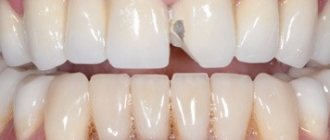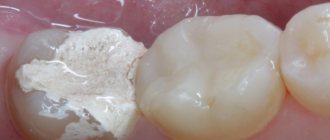Dental filling is one of the most popular services in modern dentistry. Naturally, the need to put a filling on a tooth arises for a reason: filling is carried out to restore dental units destroyed by caries, in the treatment of pulpitis and periodontitis. Putting a filling on a damaged tooth is necessary not only to close an unsightly and noticeable carious cavity. Fillings placed correctly and with high quality completely restore the aesthetics and function of the tooth.
When treating teeth, dentists can use a variety of types of fillings, but one of the most modern options is light fillings on the tooth. In the article we will tell you in detail about when you need to put a light filling on a tooth, what are the advantages and features of this type of filling material, how light fillings for chewing and front teeth differ, and also consider the prices for the service in Moscow.
Calculate the cost of treatment by taking a short test in 20 seconds!
Do not delay your treatment, because in this matter time plays against us.
What is a light filling and when does it become necessary to place it on a tooth?
What is a light filling and why do dentists recommend placing it on a tooth when treating caries? Light (photopolymer, light-curing) filling is what ordinary people far from medicine call a filling material that hardens only under the influence of ultraviolet radiation. The hardening process of light fillings occurs quickly - in just 40-60 seconds and to start it, the dentist will use a special UV lamp.
THIS IS INTERESTING: The speed of hardening of light fillings is one of their advantages. They harden under the influence of ultraviolet light in less than a minute and acquire high strength. Chemical filling composites take about 2 hours to harden.
Light fillings can be placed on teeth both for the restoration of chewing units and for high-quality restoration of teeth included in the smile zone. This type of filling material is highly durable, aesthetically pleasing, and has a wide range of shades, which allows you to select and place a light filling exactly to match the natural enamel of the patient’s teeth.
Indications for the use of light fillings are as follows:
— Treatment of caries, pulpitis, periodontitis of teeth.
During the treatment process, the dentist will drill out the tooth and remove all tissue destroyed by caries. As a result, a cavity is formed that needs to be closed both to prevent bacteria from entering the internal tissues of the tooth and to return the tooth to all its functions and attractive appearance; — You can also put a light filling on a tooth if the enamel is chipped, if part of the tooth breaks off due to a minor injury;
— In some cases, aesthetic restoration of teeth is carried out using light fillings. For example, if the tooth enamel has become very dark and cannot be whitened using professional whitening techniques.
But you should know that the decision to put a light filling on a tooth will not always be the right one - if your tooth is destroyed by more than 50%, it is better to restore it with an inlay or a crown. Light fillings have high strength, but with such tooth destruction they may not withstand constant and heavy load.
What will we get after restoration?
It does not matter whether caries completely destroyed the tooth or only changed its color. Restoration involves removing the tissue from the visible part of the tooth crown and restoring it with fillings that are similar in color to the rest of the teeth. Restoration makes it possible to restore a tooth in layers using materials required in color and purpose. All this is selected individually for each patient.
If the tooth is properly restored, it will be no different from the real one and will completely merge with the rest of the healthy teeth.
Light fillings for teeth: features and main characteristics
As we already wrote above, light fillings can be placed on both the front and chewing teeth. Photopolymer filling materials are especially in demand for the restoration of teeth included in the smile zone, because they are distinguished by high aesthetics.
Light filling materials are manufactured using nanotechnology and contain special microfillers that provide light fillings with not only high strength, but also the ability to accurately imitate the natural color of the tooth crown.
In terms of strength, light fillings are slightly inferior to chemical analogues, but at the same time they have better shock absorption and do not shrink. To increase the strength of attachment of the light filling to the dental tissues, before placing it, the dentist treats the cavity for the filling with a special adhesive composition.
Light filling for front teeth
If a light filling needs to be placed on the front teeth, which fall into the smile zone and are clearly visible to others, then a material with micro-filled components is used for restoration. Such a light filling will look as natural as possible, since it can be made with the same shade as the natural tooth enamel and polished to give the finished restoration a beautiful shine.
Light fillings for restoration of chewing teeth
When restoring chewing teeth, it is important to place a light filling on them with maximum strength, capable of withstanding constant and heavy load on the teeth when chewing food. For light fillings on chewing teeth, photopolymer composites with macrofilled components are used.
Kinds
Regardless of the type, a composite material is used to make a photopolymer filling. He can be:
- macro-filled;
- microfilled;
- minifilled;
- hybrid;
- compomer.
In addition, composites are divided into fluid and solid. They are placed in syringes and applied to the surface to be treated using tools specially designed for this purpose. Conventional ones are not suitable for this purpose, as the material will stick to them.
In case of restoration of the interdental contact point, as well as when filling the cervical area, they resort to the use of fluid polymer fillings.
It is they that fit as tightly as possible and are evenly distributed over the surface, due to which they create tight contact with hard tissues. They are easy to use. In this case, the possibility of applying more composite than necessary is completely excluded.
Let's find out why a tooth hurts after a temporary filling
In the process of restoration of anterior teeth, it is customary to use solid photopolymers. They are plastic, thanks to which they can give the tooth any shape and will fully correspond to the anatomical structure.
When restoring a large cavity, the material is applied in layers, since the rays of the lamp cannot penetrate into the deep layers. For more reliable fixation, the enamel is highlighted first and only then the remaining areas.
Advantages and disadvantages of light fillings on teeth
Compared to other types of fillings, light fillings have a number of advantages:
- The high plasticity of the material gives the dentist the opportunity to form a high-quality filling and, therefore, to thoroughly fill the cavity and all surface defects of the tooth being restored. The same quality of light fillings makes it possible to apply the material in layers and thereby ensure maximum strength of its adhesion to the natural tissues of the tooth;
- Hypoallergenic. All components included in the light fillings are not capable of causing allergic reactions in people;
- Light fillings make it possible to accurately reproduce the color of natural tooth enamel. To obtain the desired shade of the filling that is planned to be placed on the tooth, the dentist can mix several shades of material;
- Even when the material has completely hardened, the light fillings can still be properly sanded and polished. This has a positive effect on the level of aesthetics of the finished restoration.
But despite the large number of advantages, light fillings also have certain disadvantages. In particular, a light filling cannot be placed on a tooth if the tooth is significantly damaged. In addition, over time, such restorations can chip and change color. In this case, you will need to replace the light seal.
Materials
The filling mixtures include environmentally friendly components that are safe for human health:
- polymer matrix (thanks to blue light waves with a length of 450 nanometers, it hardens);
- filler (barium glass particles, glass ceramics, silicon dioxide, etc.);
- a binding agent (for example, silanes - compounds of hydrogen and silicon).
Most often, composites from the following manufacturers are used for light fillings:
- Fuji (Japan);
- Noritake (Japan);
- Kerr (USA);
- Dipol (USA);
- Bisco (USA);
- GC America (USA);
- Degussa (Germany).
Photopolymer from the American company Kerr
Putting a light filling on a tooth: how the treatment process will proceed
Treatment and restoration of a tooth with a light filling always begins with an examination of the patient’s oral cavity - this is necessary to make a diagnosis and select the correct treatment plan. If the examination is not enough for an accurate diagnosis, the patient is sent for an X-ray. Further tooth treatment and installation of a light filling will include the following steps:
1. Local anesthesia is given. The installation of the light filling itself is painless, but before this event the dentist will need to treat the tooth tissue and this can cause pain to the person.
2. The tooth being filled is protected from saliva by a rubber dam - a special latex lining that will prevent moisture from entering the cavity being treated. Even the smallest particles of moisture can negatively affect the strength and reliability of the restoration!
3. The dentist works with a diseased tooth, removing teeth damaged and destroyed by caries and forming a cavity for installing a filling. If caries has destroyed the tooth almost to the pulp, removal of the dental nerve may be required, as well as treatment and filling of the dental canals.
4. Having formed and treated the cavity in the tooth with antiseptics, the doctor will begin choosing the shade of the future light filling. A special scale is used for this; the dentist can also mix several shades of photopolymer material to obtain the color of the light filling that will perfectly match the tone of the natural tooth enamel.
5. The tooth cavity is dried and covered with a preparation based on orthophosphoric acid for 40 seconds. This drug improves the adhesion of the light filling to the natural tissues of the tooth.
6. After the specified exposure time, the drug with adhesive properties is washed off, and the cavity is thoroughly dried again.
7. Adhesive is applied to the tooth tissue, and then the doctor will begin laying out the filling material in layers. Each laid layer is exposed to ultraviolet radiation to ensure high-quality hardening and increase the strength of the light seal.
The procedure for installing a light filling ends with grinding and polishing of the restoration. On average, it takes a dentist 40-50 minutes to install one medium-sized filling.
Naturally, the treatment process and installation of a light filling for pulpitis and periodontitis will be longer. After all, before placing a light filling on a tooth, the doctor must make sure that the inflammatory process is completely eliminated.
Is anesthesia necessary in all cases?
Regardless of whether a Japanese dental filling is used or a product from another manufacturer is installed, anesthesia is a prerequisite. This not only helps to quickly eliminate pain, but also ensures the impeccable quality of the work performed, since the dentist has free access to the damaged cavity.
However, the use of strong painkillers is not recommended in all cases. If a superficial lesion is detected, to reduce sensitivity it is advisable to apply the application to a shallow depth (no more than 3 mm). Usually the cost of such a procedure does not exceed 200 rubles. In case of massive destruction, the cost of pain relief can reach 1 thousand rubles.
We placed a light filling on a tooth: when can you start eating?
Light fillings are strong and reliable, and some dentists say that the patient can start eating almost immediately after their installation procedure. However, it will be healthier to refrain from eating for about 1-2 hours after you have a light filling placed on your tooth.
For three to four days after the light filling is installed, it is recommended to refrain from eating too hard foods and foods with coloring pigments. If you eat sweets, do not forget to rinse your mouth, because sweet and starchy foods provoke the active proliferation of carious bacteria.
Light fillings on teeth: service life and tips to help avoid fillings falling out
If, after treating the tooth and installing a light filling, you strictly follow all the doctor’s recommendations, the restoration can serve you for 7-10 years without breaking or losing its visual appeal. In particular, you need to brush your teeth daily (at least twice a day), using not only a toothbrush and toothpaste, but also dental floss and mouthwash.
It is important to monitor your diet - it should contain a minimum of sweet foods and as much food rich in calcium as possible.
Smokers, people who abuse coffee and tea may need to change the filling earlier, as it may change its color from contact with the pigments of tobacco and drinks.
If you do not want the installed light seal to chip or fall out, do not do the following:
- Do not use ultrasonic brushes to clean your teeth, this can lead to loosening and loss of the filling;
- Remember that smoking and alcohol abuse can lead to a rapid loss of the aesthetic appearance of the light filling;
- Do not pick the line between the filling and the tooth with toothpicks.
If the filling suddenly chips, falls out, or you just want to restore its aesthetic appearance, do not try to restore it yourself, following advice from the Internet - contact the dentist.
Alternatives
There can be two alternatives for restorations:
- Removal and installation of a dental crown made of ceramics or metal-ceramics.
- Inlays instead of fillings. They are more expensive, but have a long service life and are also very reliable.
Photo of a dental inlay and crown
In conclusion, we can conclude that all types of fillings for restoration after caries are different and, accordingly, have different service lives. It’s better, of course, to spare no expense and get a good filling done once, than to go to the dentist every six months and get a new restoration done. Regarding the need for such a procedure, the patient must understand that the teeth must be not only healthy, but also beautiful, and therefore they cannot do without restoration after treatment.
The fillings do not require special care; you just need to follow the usual rules of hygiene and then caries will leave you forever. If we take into account all the pros and cons, then restoration with any types of fillings is the best solution after caries treatment.
Prices for installing a light seal
The cost of installing a light filling will largely depend on the dental disease that needs to be treated and also on the volume of filling material required for high-quality tooth restoration. If you need to put a small light filling on a tooth, then the price of the service can vary between 2000 -3000 rubles. Large fillings for caries that have severely damaged teeth are more expensive - from 3,000 to 4,000 rubles.
Installing a filling for pulpitis and periodontitis will cost even more. Here the price of treatment will range from 5 to 10,000 rubles.
You can find out the exact cost of a light filling only after visiting the dentist’s office and undergoing an examination! We would like to draw your attention to the following point: the service life of light fillings depends on the quality of the materials and on the level of professionalism of the doctor who will carry out the treatment and restoration of the tooth. The risks of complications after installing a filling also depend on these factors. If the doctor makes mistakes when treating deep caries and pulpitis, the tooth under the filling may begin to hurt. Naturally, a poorly installed seal can chip or fall out at any time. Therefore, when planning to put light fillings on your teeth, always carefully choose dentistry for your treatment!
Calculate the cost of treatment by taking a short test in 20 seconds!
Do not delay your treatment, because in this matter time plays against us.
Cost of filling after caries
The cost includes the price of the material the dentist uses to make the fillings. The final price will depend on the choice of material. The most expensive are chemical and light-curing fillings, since the material is matched to the color of the tooth and is quite durable. Cement and amalgam are inexpensive options.
In general, the cost of a filling depends on the clinic and whether pain medication was used. In addition, you need to take into account that the price of restoration includes the cost of x-rays.
Restoration of teeth using light fillings at VENSTOM dentistry in Moscow
In our dental clinic in Moscow - "VENSTOM" - dental restoration is carried out using high-quality photopolymer (light) filling materials from the world's leading manufacturers. Light seals made from such materials have a high level of aesthetics and maximum strength and reliability.
Dental treatment and installation of light fillings in our clinic are carried out in conditions that are comfortable for the patient and by experienced specialists who have the necessary knowledge base and experience to carry out high-quality dental restoration!
Do you still have questions about light fillings and dental treatment? Just dial the contact phone number of our clinic or write to the interactive chat on our website! We will honestly answer your questions and offer the widest range of dental services for the health of your teeth and the beauty of your smile!
Let's sum it up
There are many types of dental fillings for filling teeth, which differ in materials of manufacture, purpose and other criteria. The type of product is selected together with the attending physician. In this case, it is important to take into account the quality of adhesion to natural surfaces, aesthetic properties, hardening speed and other points. For many patients, the cost of installation is a deciding factor, so strength and durability take a back seat.
The price depends on many factors, for this reason it is important to carefully consider the choice of treatment method. Having figured out what types of permanent dental fillings there are (the names of the types are discussed above), you can forget about pain and other discomfort for a long time, enjoying a dazzling smile.










